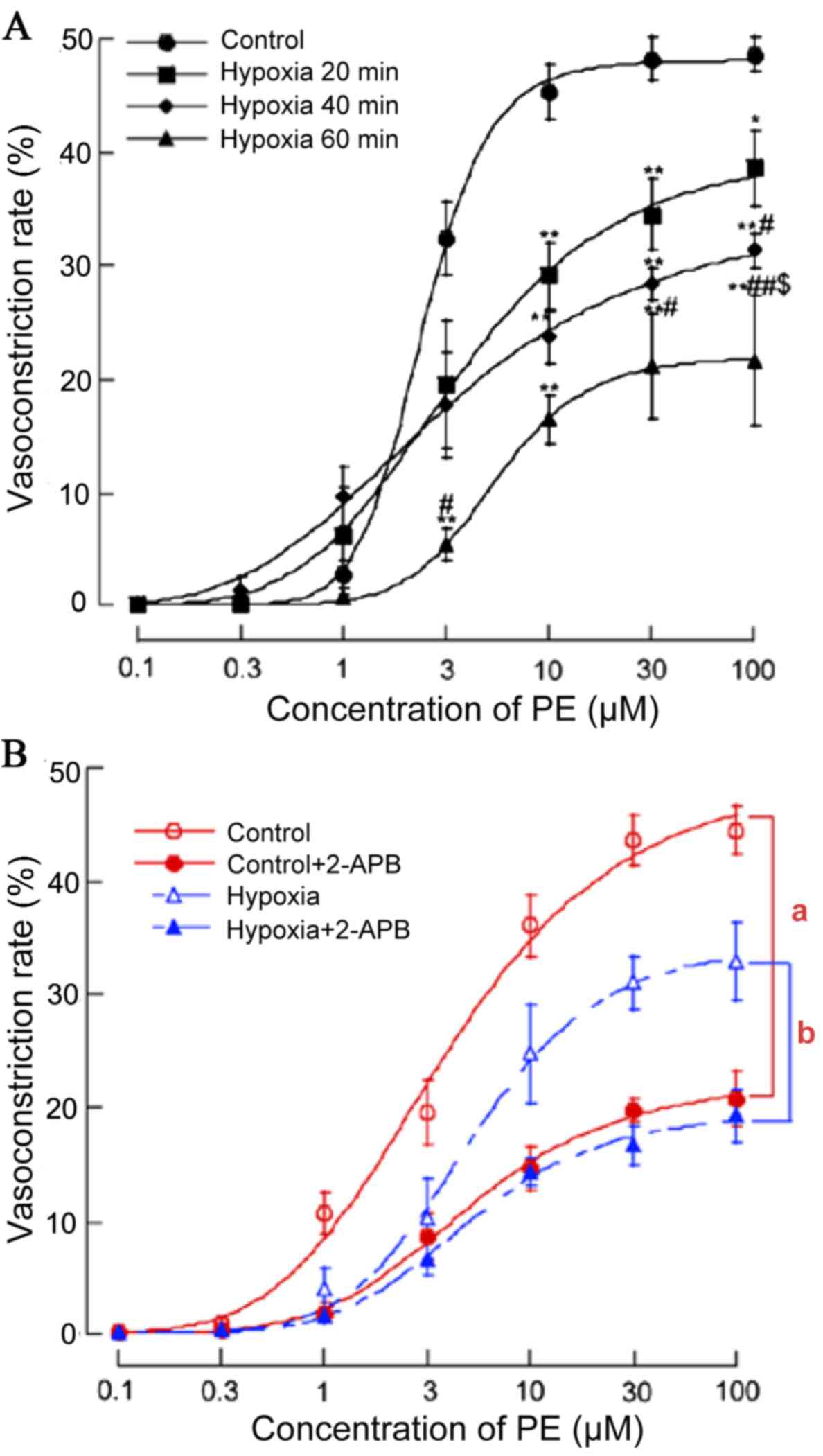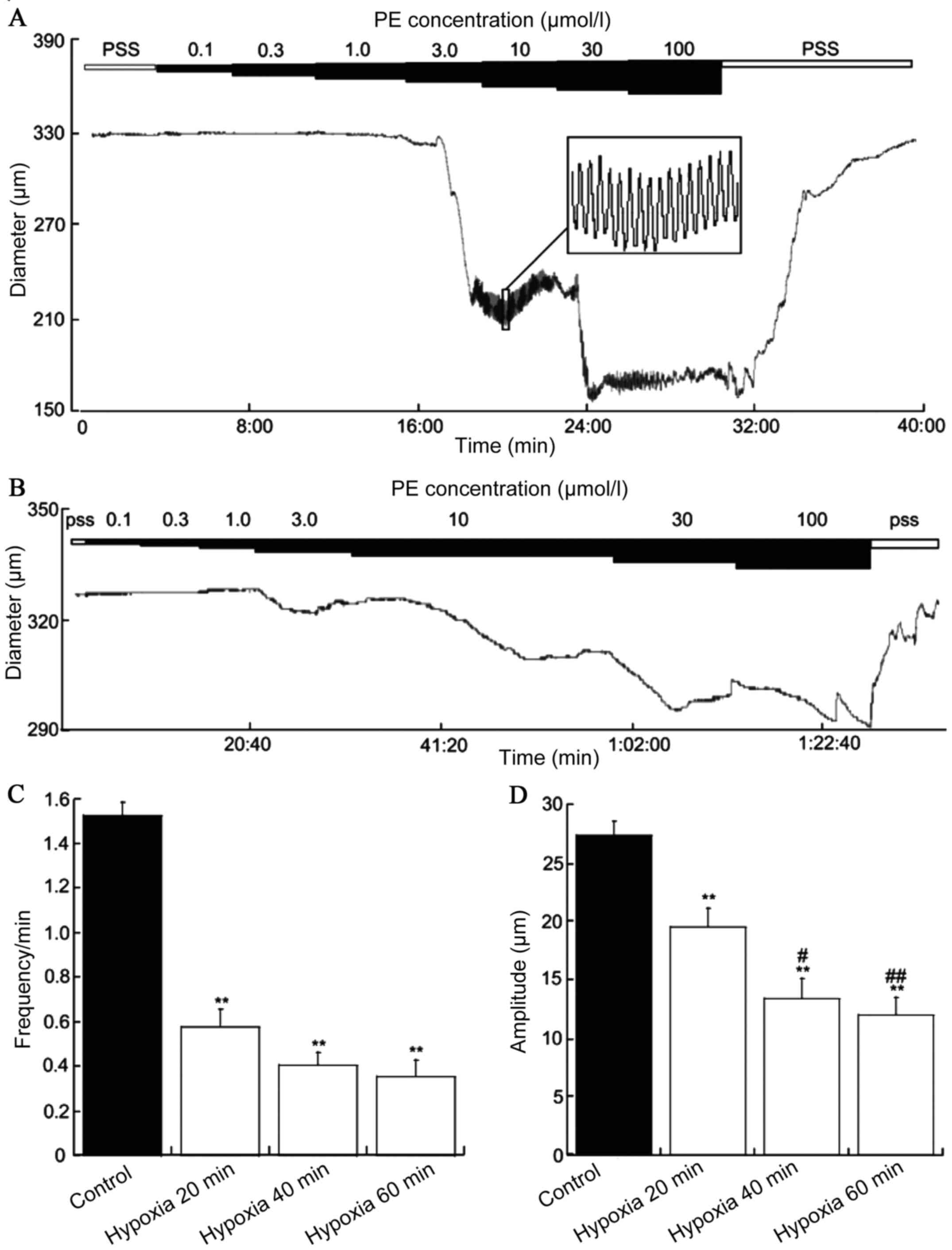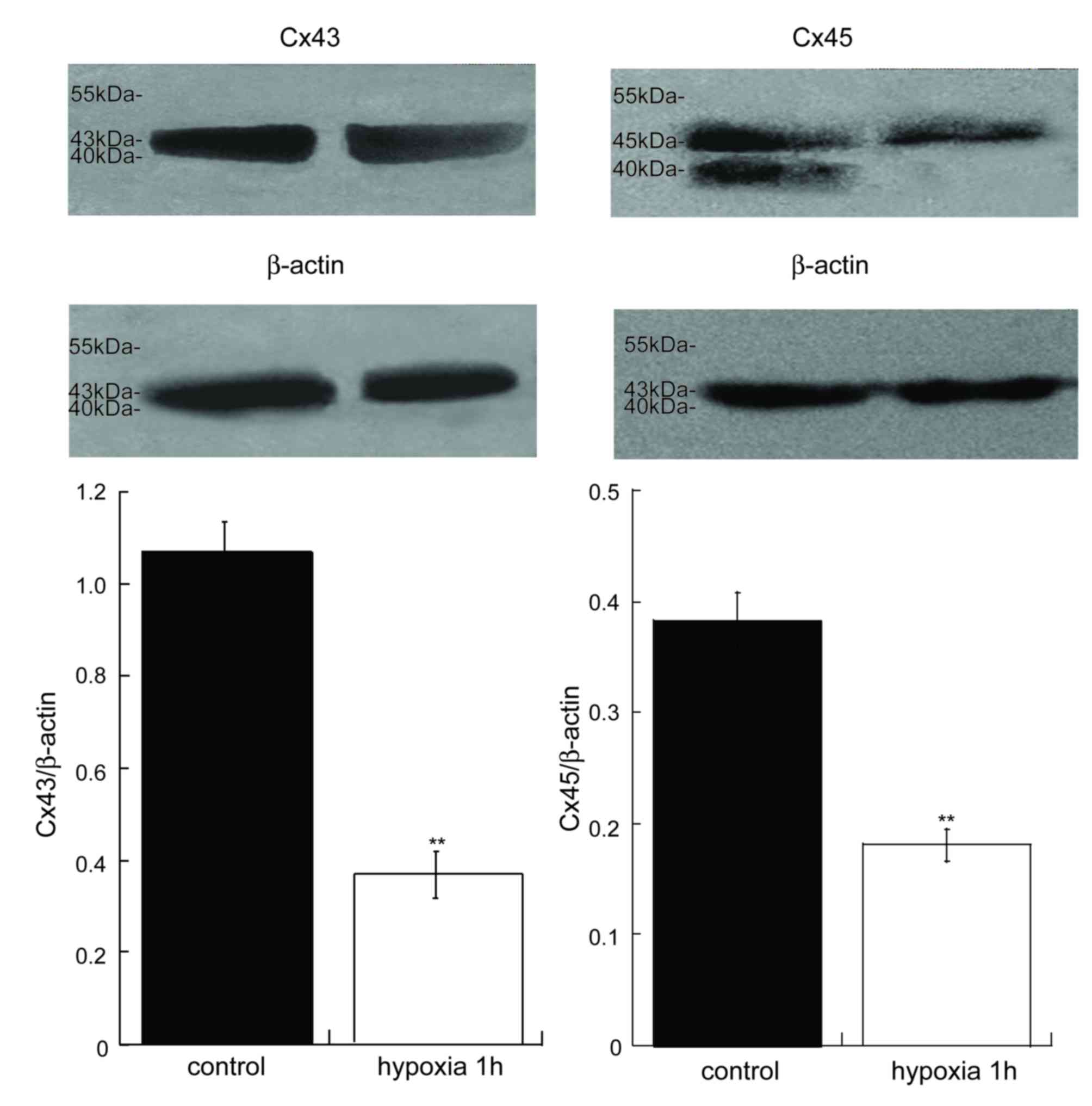|
1
|
Wanandi SI, Reni P and Syarifah D:
Relative expression of HIF-1α mRNA in rat heart, brain and blood
during induced systemic hypoxia. Makara Seri Sains. 13:185–188.
2009.
|
|
2
|
Lohman AW, Billaud M and Isakson BE:
Mechanisms of ATP release and signalling in the blood vessel wall.
Cardiovasc Res. 95:269–280. 2012. View Article : Google Scholar : PubMed/NCBI
|
|
3
|
Ainslie PN, Ogoh S, Burgess K, Celi L,
McGrattan K, Peebles K, Murrell C, Subedi P and Burgess KR:
Differential effects of acute hypoxia and high altitude on cerebral
blood flow velocity and dynamic cerebral auto regulation:
alterations with hyperoxia. J Appl Physiol. 104:490–498. 2008.
View Article : Google Scholar : PubMed/NCBI
|
|
4
|
Tawaa M, Shimosato T, Geddawy A, Imamura T
and Okamura T: Influence of hypoxia on endothelium-derived
no-mediated relaxation in rat carotid, mesenteric and iliac
arteries. Pharmacology. 91:322–330. 2013. View Article : Google Scholar : PubMed/NCBI
|
|
5
|
Zhdanov GG and Sokolov IM: Tissue hypoxia
in acute myocardial infarction and possible approaches to its
correction. Anesteziol Reanimatol. 51–53. 2001.(In Russian).
PubMed/NCBI
|
|
6
|
Ariyaratnam P, Loubani M and Morice AH:
Hypoxic pulmonary vasoconstriction in humans. Biomed Res Int.
2013:6236842013. View Article : Google Scholar : PubMed/NCBI
|
|
7
|
Wan J, Yamamura A, Zimnicka AM, Voiriot G,
Smith KA, Tang H, Ayon RJ, Choudhury MS, Ko EA, Wang J, et al:
Chronic hypoxia selectively enhances L- and T-type
voltage-dependent Ca2+ channel activity in pulmonary artery by
upregulating Cav1.2 and Cav3.2. Am J Physiol Lung Cell Mol Physiol.
305:L154–L164. 2013. View Article : Google Scholar : PubMed/NCBI
|
|
8
|
Al-Shraim MM, Zafer MH and Rahman GA:
Acute occlusive mesenteric ischemia in high altitude of
southwestern region of Saudi Arabia. Ann Afr Med. 11:5–10. 2012.
View Article : Google Scholar : PubMed/NCBI
|
|
9
|
Figueroa XF and Duling BR: Gap junctions
in the control of vascular function. Antioxid Redox Signal.
11:251–266. 2009. View Article : Google Scholar : PubMed/NCBI
|
|
10
|
Rummery NM and Hill CE: Vascular gap
junctions and implications for hypertension. Clin Exp Pharmacol
Physiol. 31:659–667. 2004. View Article : Google Scholar : PubMed/NCBI
|
|
11
|
Wang L, Yin J, Nickles HT, Ranke H,
Tabuchi A, Hoffmann J, Tabeling C, Barbosa-Sicard E, Chanson M,
Kwak BR, et al: Hypoxic pulmonary vasoconstriction requires
connexin 40-mediated endothelial signal conduction. J Clin Invest.
122:4218–4230. 2012. View
Article : Google Scholar : PubMed/NCBI
|
|
12
|
Waza AA, Andrabi K and Hussain MU: Protein
kinase C (PKC) mediated interaction between conexin43 (Cx43) and
K(+) (ATP) channel subunit (Kir6.1) in cardiomyocyte mitochondria:
Implications in cytoprotection against hypoxia induced cell
apoptosis. Cell Signal. 26:1909–1917. 2014. View Article : Google Scholar : PubMed/NCBI
|
|
13
|
Martins-Marques T, Catarino S, Marques C,
Matafome P, Ribeiro-Rodrigues T, Baptista R, Pereira P and Girão H:
Heart ischemia results in connexin43 ubiquitination localized at
the intercalated discs. Biochimie. 112:196–201. 2015. View Article : Google Scholar : PubMed/NCBI
|
|
14
|
Miura T, Miki T and Yano T: Role of the
gap junction in ischemic preconditioning in the heart. Am J Physiol
Heart Circ Physiol. 298:H1115–H1125. 2010. View Article : Google Scholar : PubMed/NCBI
|
|
15
|
Turner MS, Haywood GA, Andreka P, You L,
Martin PE, Evans WH, Webster KA and Bishopric NH: Reversible
connexin 43 dephosphorylation during hypoxia and reoxygenation is
linked to cellular ATP levels. Circ Res. 95:726–733. 2004.
View Article : Google Scholar : PubMed/NCBI
|
|
16
|
Faigle M, Seessle J, Zug S, El Kasmi KC
and Eltzschig HK: ATP release from vascular endothelia occurs
across Cx43 hemichannels and is attenuated during hypoxia. PLoS
One. 3:e28012008. View Article : Google Scholar : PubMed/NCBI
|
|
17
|
Matsushita S, Kurihara H, Watanabe M,
Okada T, Sakai T and Amano A: Alterations of phosphorylation state
of connexin 43 during hypoxia and reoxygenation are associated with
cardiac function. J Histochem Cytochem. 54:343–353. 2006.
View Article : Google Scholar : PubMed/NCBI
|
|
18
|
Wu X, Huang W, Luo G and Alain LA: Hypoxia
induces connexin 43 dysregulation by modulating matrix
metalloproteinases via MAPK signaling. Mol Cell Biochem.
384:155–162. 2013. View Article : Google Scholar : PubMed/NCBI
|
|
19
|
Nuñez C, Victor VM, Martí M and D'Ocon P:
Role of endothelial nitric oxide in pulmonary and systemic arteries
during hypoxia. Nitric Oxide. 15:17–27. 2014. View Article : Google Scholar
|
|
20
|
Ibe JC, Zhou Q, Chen T, Tang H, Yuan JX,
Raj JU and Zhou G: Adenosine monophosphate-activated protein kinase
is required for pulmonary artery smooth muscle cell survival and
the development of hypoxic pulmonary hypertension. Am J Respir Cell
Mol Biol. 49:609–618. 2013. View Article : Google Scholar : PubMed/NCBI
|
|
21
|
Lee YH, Seo JH and Kang BS: Effects of
hypoxia on pulmonary vascular contractility. Yonsei Med J.
39:261–267. 1998. View Article : Google Scholar : PubMed/NCBI
|
|
22
|
Ma KT, Li XZ, Li L, Jiang XW, Chen XY, Liu
WD, Zhao L, Zhang ZS and Si JQ: Role of gap junctions in the
contractile response to agonists in the mesenteric artery of
spontaneously hypertensive rats. Hypertens Res. 37:110–115. 2014.
View Article : Google Scholar : PubMed/NCBI
|
|
23
|
Ma KT, Guan BC, Yang YQ, Nuttall AL and
Jiang ZG: 2-Aminoethoxydiphenyl borate blocks electrical coupling
and inhibits voltage-gated K+ channels in guinea pig arteriole
cells. Am J Physiol Heart Circ Physiol. 300:H335–H346. 2011.
View Article : Google Scholar : PubMed/NCBI
|
|
24
|
Li L, Wang R, Ma KT, Li XZ, Zhang CL, Liu
WD, Zhao L and Si JQ: Differential effect of calcium-activated
potassium and chloride channels on rat basilar artery vasomotion. J
Huazhong Univ Sci Technolog Med Sci. 34:482–490. 2014. View Article : Google Scholar : PubMed/NCBI
|
|
25
|
Wang R, Zhang C, Ruan Y, Liu N and Wang L:
Change in phosphorylation of connexin43 during acute hypoxia and
effects of antiarrhythmic peptide on the phosphorylation. J
Huazhong Univ Sci Technolog Med Sci. 27:241–244. 2007. View Article : Google Scholar : PubMed/NCBI
|
|
26
|
Kato R, Ishihara Y, Kawanabe N, Sumiyoshi
K, Yoshikawa Y, Nakamura M, Imai Y, Yanagita T, Fukushima H,
Kamioka H, et al: Gap-junction-mediated communication in human
periodontal ligament cells. J Dent Res. 92:635–640. 2013.
View Article : Google Scholar : PubMed/NCBI
|
|
27
|
Naitoh K, Yano T, Miura T, Itoh T, Miki T,
Tanno M, Sato T, Hotta H, Terashima Y and Shimamoto K: Roles of
Cx43-associated protein kinases in suppression of gap
junction-mediated chemical coupling by ischemic preconditioning. Am
J Physiol Heart Circ Physiol. 296:H396–H403. 2009. View Article : Google Scholar : PubMed/NCBI
|
|
28
|
Sato M, Jiao Q, Honda T, Kurotani R,
Toyota E, Okumura S, Takeya T, Minamisawa S, Lanier SM and Ishikawa
Y: Activator of G protein signaling 8 (AGS8) is required for
hypoxia-induced apoptosis of cardiomyocytes: Role of G betagamma
and connexin 43 (Cx43). J Biol Chem. 284:31431–31440. 2009.
View Article : Google Scholar : PubMed/NCBI
|
|
29
|
Li WE and Nagy JI: Connexin43
phosphorylation state and intercellular communication in cultured
astrocytes following hypoxia and protein phosphatase inhibition.
Eur J Neurosci. 12:2644–2650. 2000. View Article : Google Scholar : PubMed/NCBI
|
|
30
|
Li W, Hertzberg EL and Spray DC:
Regulation of connexin43-protein binding in astrocytes in response
to chemical ischemia/hypoxia. J Biol Chem. 280:7941–7948. 2005.
View Article : Google Scholar : PubMed/NCBI
|
|
31
|
Li XZ, Si JQ, Zhang ZS, Zhao L, Li L and
Ma KT: Acute hypoxia increases outward current and decreases gap
junction of VSMCs in guinea-pig anterior inferior cerebellar
artery. Sheng Li Xue Bao. 63:533–539. 2011.(In Chinese). PubMed/NCBI
|
|
32
|
Guan BC, Si JQ and Jiang ZG: Blockade of
gap junction coupling by glycyrrhetinic acids in guinea pig
cochlear artery: A whole-cell voltage- and current-clamp study. Br
J Pharmacol. 151:1049–1060. 2007. View Article : Google Scholar : PubMed/NCBI
|
|
33
|
Quinn K and Beech DJ: A method for direct
patch-clamp recording from smooth muscle cells embedded in
functional brain microvessels. Pflugers Arch. 435:564–569. 1998.
View Article : Google Scholar : PubMed/NCBI
|
|
34
|
Yamamoto Y, Fukuta H, Nakahira Y and
Suzuki H: Blockade by 18beta-glycyrrhetinic acid of intercellular
electrical coupling in guinea-pig arterioles. J Physiol.
511:501–508. 1998. View Article : Google Scholar : PubMed/NCBI
|
|
35
|
Beardslee MA, Lerner DL, Tadros PN, Laing
JG, Beyer EC, Yamada KA, Kléber AG, Schuessler RB and Saffitz JE:
Dephosphorylation and intracellular redistribution of ventricular
connexin43 during electrical uncoupling induced by ischemia. Circ
Res. 87:656–662. 2000. View Article : Google Scholar : PubMed/NCBI
|
|
36
|
Solan JL and Lampe PD: Connexin43
phosphorylation: Structural changes and biological effects. Biochem
J. 419:261–272. 2009. View Article : Google Scholar : PubMed/NCBI
|
|
37
|
Le HT, Sin WC, Lozinsky S, Bechberger J,
Vega JL, Guo XQ, Sáez JC and Naus CC: Gap junction intercellular
communication mediated by connexin43 in astrocytes is essential for
their resistance to oxidative stress. J Biol Chem. 289:1345–1354.
2014. View Article : Google Scholar : PubMed/NCBI
|
|
38
|
Srisakuldee W, Makazan Z, Nickel BE, Zhang
F, Thliveris JA, Pasumarthi KB and Kardami E: The FGF-2-triggered
protection of cardiac subsarcolemmal mitochondria from calcium
overload is mitochondrial connexin 43-dependent. Cardiovasc Res.
103:72–80. 2014. View Article : Google Scholar : PubMed/NCBI
|
|
39
|
Shimizu K and Stopfer M: Gap junctions.
Curr Biol. 23:R1026–R1031. 2013. View Article : Google Scholar : PubMed/NCBI
|
|
40
|
Goodenough DA and Paul DL: Gap Junctions.
Cold Spring Harb Perspect Biol. 1:a0025762009. View Article : Google Scholar : PubMed/NCBI
|
|
41
|
Saffitz JE, Laing JG and Yamada KA:
Connexin expression and turnover: Implications for cardiac
excitability. Circ Res. 86:723–728. 2000. View Article : Google Scholar : PubMed/NCBI
|
|
42
|
Lampe PD, Kurata WE, Warn-Cramer BJ and
Lau AF: Formation of a distinct connexin43 phosphoisoform in
mitotic cells is dependent upon p34cdc2 kinase. J Cell Sci.
111:833–841. 1998.PubMed/NCBI
|
|
43
|
Hertlein B, Butterweck A, Haubrich S,
Willecke K and Traub O: Phosphorylated carboxy terminal serine
residues stabilize the mouse gap junction protein connexin45
against degradation. J Membr Biol. 162:247–257. 1998. View Article : Google Scholar : PubMed/NCBI
|
|
44
|
Wang X, Ma A, Zhu W, Zhu L, Zhao Y, Xi J,
Zhang X and Zhao B: The role of connexin 43 and hemichannels
correlated with the astrocytic death following ischemia/reperfusion
insult. Cell Mol Neurobiol. 33:401–410. 2013. View Article : Google Scholar : PubMed/NCBI
|
|
45
|
Krysko DV, Leybaert L, Vandenabeele P and
D'Herde K: Gap junctions and the propagation of cell survival and
cell death signals. Apoptosis. 10:459–469. 2005. View Article : Google Scholar : PubMed/NCBI
|
|
46
|
Madden JA, Vadula MS and Kurup VP: Effects
of hypoxia and other vasoactive agents on pulmonary and cerebral
artery smooth muscle cells. Am J Physiol. 263:L384–L393.
1992.PubMed/NCBI
|
|
47
|
Jain SK, Schuessler RB and Saffitz JE:
Mechanisms of delayed electrical uncoupling induced by ischemic
preconditioning. Circ Res. 92:1138–1144. 2003. View Article : Google Scholar : PubMed/NCBI
|
|
48
|
Kovacs G, Montalbetti N, Simonin A, Danko
T, Balazs B, Zsembery A and Hediger MA: Inhibition of the human
epithelial calcium channel TRPV6 by 2-aminoethoxydiphenyl borate
(2-APB). Cell Calcium. 52:468–480. 2012. View Article : Google Scholar : PubMed/NCBI
|
|
49
|
Colton CK and Zhu MX:
2-Aminoethoxydiphenyl borate as a common activator of TRPV1, TRPV2,
and TRPV3 channels. Handb Exp Pharmacol. 173–187. 2007. View Article : Google Scholar : PubMed/NCBI
|
|
50
|
Pan F, Mills SL and Massey SC: Screening
of gap junction antagonists on dye coupling in the rabbit retina.
Vis Neurosci. 24:609–618. 2007. View Article : Google Scholar : PubMed/NCBI
|
|
51
|
Neijssen J, Herberts C, Drijfhout JW,
Reits E, Janssen L and Neefjes J: Cross-presentation by
intercellular peptide transfer through gap junctions. Nature.
434:83–88. 2005. View Article : Google Scholar : PubMed/NCBI
|
|
52
|
Griffith TM, Chaytor AT, Bakker LM and
Edwards DH: 5-Methyltetrahydrofolate and tetrahydrobiopterin can
modulate electrotonically mediated endothelium-dependent vascular
relaxation. Proc Natl Acad Sci USA. 102:7008–7013. 2005. View Article : Google Scholar : PubMed/NCBI
|
|
53
|
Hashitani H, Yanai Y and Suzuki H: Role of
interstitial cells and gap junctions in the transmission of
spontaneous Ca2+ signals in detrusor smooth muscles of the
guinea-pig urinary bladder. J Physiol. 559:567–581. 2004.
View Article : Google Scholar : PubMed/NCBI
|
|
54
|
Li C, Meng Q, Yu X, Jing X, Xu P and Luo
D: Regulatory effect of connexin 43 on basal Ca2+ signaling in rat
ventricular myocytes. PLoS One. 7:e361652012. View Article : Google Scholar : PubMed/NCBI
|
|
55
|
Halidi N, Alonso F, Burt JM, Bény JL,
Haefliger JA and Meister JJ: Intercellular calcium waves in primary
cultured rat mesenteric smooth muscle cells are mediated by
Connexin43. Cell Commun Adhes. 19:25–37. 2012. View Article : Google Scholar : PubMed/NCBI
|
|
56
|
Kurtz A: Renal connexins and blood
pressure. Biochim Biophys Acta. 1818:1903–1908. 2012. View Article : Google Scholar : PubMed/NCBI
|
|
57
|
Schmidt VJ, Jobs A, von Maltzahn J,
Wörsdörfer P, Willecke K and de Wit C: Connexin45 is expressed in
vascular smooth muscle but its function remains elusive. PLos One.
7:e422872012. View Article : Google Scholar : PubMed/NCBI
|












